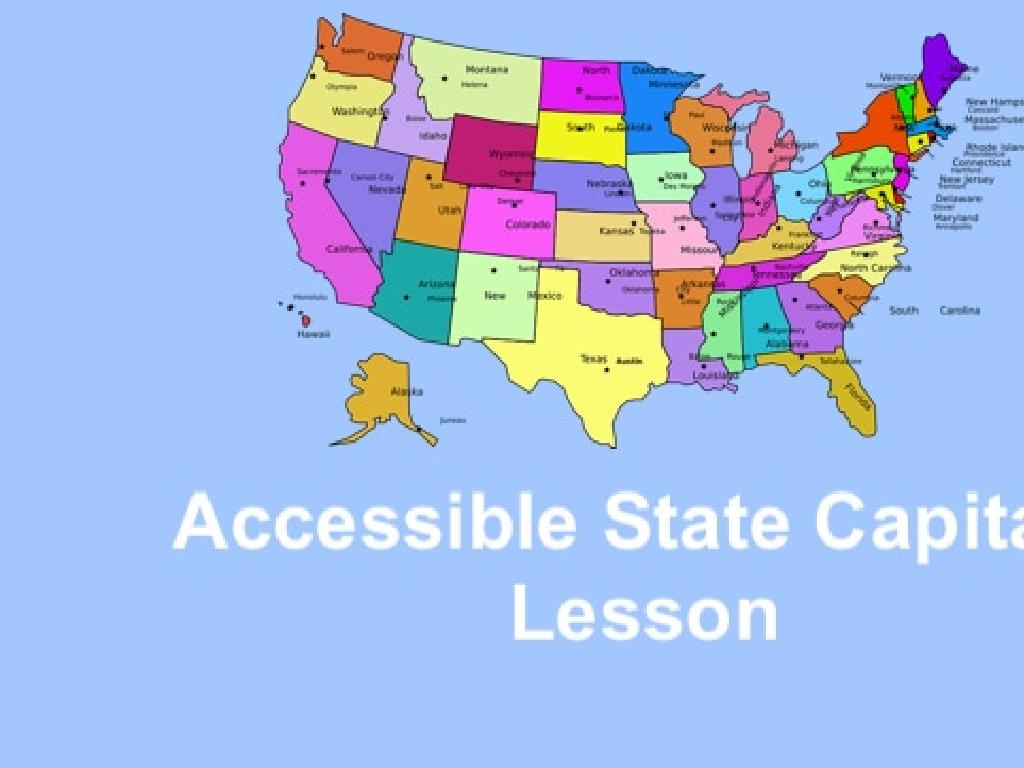Abbreviate Temperature, Mass, And Volume Units
Subject: Science
Grade: Sixth grade
Topic: Units And Measurement
Please LOG IN to download the presentation. Access is available to registered users only.
View More Content
Basics of Measurement: Units in Science
– Understanding measurement
– Measurement is comparing an object to a standard unit
– Need for standard units
– Standard units are consistent and understood globally
– Temperature, mass, and volume
– These are fundamental properties we measure in science
– Abbreviations in science
– E.g., Celsius (°C), Grams (g), Liters (L)
|
This slide introduces the concept of measurement and its importance in science. Measurement is the process of comparing an object or phenomenon to a standard unit, which allows us to quantify and communicate findings accurately. Standard units are essential for consistency and global understanding; without them, scientific data would be confusing and unreliable. We focus on temperature, mass, and volume as key measurable properties in science, and students will learn common abbreviations such as degrees Celsius for temperature, grams for mass, and liters for volume. Emphasize the importance of memorizing these abbreviations as they are widely used in scientific calculations and reporting.
Understanding Temperature Units
– What is temperature?
– Measure of how hot or cold something is
– Celsius and Fahrenheit scales
– °C used globally, °F mainly in the U.S.
– Reading a thermometer
– Match temperature with scale marking
– Practice abbreviating units
– Convert temperatures and use °C, °F
|
This slide introduces the concept of temperature and its measurement units to the students. Begin by explaining temperature as a measure of the warmth or coldness of an object or environment. Introduce Celsius (°C) and Fahrenheit (°F) as the two main scales used to measure temperature, noting that °C is used worldwide while °F is primarily used in the United States. Demonstrate how to read a thermometer by matching the liquid’s level to the scale’s marking. Finally, engage students in practicing how to abbreviate temperature units and convert between Celsius and Fahrenheit. Provide examples and exercises for students to apply these concepts.
Abbreviating Temperature Units
– Abbreviate Celsius: ‘°C’
– Abbreviate Fahrenheit: ‘°F’
– Everyday examples of °C and °F
– Weather reports, cooking recipes, and science experiments often use °C or °F to indicate temperature.
|
This slide introduces students to the abbreviations for Celsius and Fahrenheit, the two most commonly used temperature scales. Celsius, denoted as ‘°C’, is used worldwide and is the standard unit of temperature in most countries. Fahrenheit, represented as ‘°F’, is primarily used in the United States for everyday applications. Provide examples such as weather forecasts, where temperatures are given in °C or °F, or in cooking, where oven temperatures are often listed in both units. Explain that in science class, they will mostly use Celsius. Encourage students to become familiar with both units and to practice converting between them.
Understanding Mass and Its Units
– Mass: Measure of matter
– Mass is the amount of matter in an object, not its weight.
– Common units: grams & pounds
– Grams (g) are used for small objects, pounds (lb) for larger ones.
– Measuring mass with scales
– Scales help us find how much matter is in an object.
– Importance of accurate measurement
|
This slide introduces the concept of mass as a fundamental property of matter, distinct from weight which is affected by gravity. Emphasize that grams are typically used in scientific contexts and for smaller objects, while pounds are more common in everyday use in the United States for measuring heavier items. Demonstrate how to use a scale to measure mass, and discuss the importance of using the correct units for scientific accuracy. Encourage students to think about why different units might be used for different purposes and the relevance of precise measurement in science.
Abbreviating Mass Units
– Abbreviate grams to ‘g’
– Abbreviate pounds to ‘lb’
– Use in recipes
– Recipes often list ingredients in grams or pounds, e.g., ‘500g flour’, ‘2lb sugar’
– Apply in grocery shopping
– Grocery items are labeled with ‘lb’ for weight, like ‘3lb apples’
|
This slide aims to teach students how to abbreviate units of mass commonly used in everyday life, such as in cooking and shopping. Grams are abbreviated as ‘g’, and pounds as ‘lb’. It’s important for students to recognize these abbreviations in practical scenarios like following a recipe or weighing produce at the grocery store. Encourage students to bring in examples of recipes or grocery labels and discuss how the mass is represented. This will help them become familiar with the concept of mass and its measurement in real-world contexts.
Understanding Volume Units
– Volume: space a substance occupies
– Common units: Liters (L) and gallons (gal)
– 1 L = 0.264172 gal, often used for larger quantities of liquid
– Kitchen uses: measuring ingredients
– Recipes use liters or gallons for liquids like water, milk, or oil
– Science experiments: precise measurements
– Accurate volume measurement is crucial for experiment success
|
This slide introduces the concept of volume as the amount of space that a substance (usually a liquid) occupies. Emphasize the two common units of volume: liters and gallons, and explain the conversion between them. Highlight the practical use of these units in everyday life, such as in cooking, where recipes may require precise amounts of liquid ingredients measured in liters or gallons. Also, discuss the importance of measuring volume accurately in science experiments to ensure the validity of results. Encourage students to think of examples where they have encountered these units in their own experiences.
Abbreviating Volume Units
– Abbreviate liters to ‘L’
– ‘L’ is the abbreviation for liters, the metric unit of volume
– Abbreviate gallons to ‘gal’
– ‘gal’ stands for gallons, used in the U.S. customary system
– Examples of volume in life
– Milk is often sold in gallons and water bottles in liters
|
This slide introduces students to the common abbreviations for volume units, specifically liters and gallons. Explain that ‘L’ is used for liters, which is part of the metric system, and ‘gal’ is for gallons, which is part of the U.S. customary system. Provide relatable examples such as milk sold in gallons and water sold in liters to help students visualize and understand the practical use of these units in everyday life. Encourage students to look for these abbreviations on labels of drinks and other liquid products to reinforce their learning.
Class Activity: Measurement Scavenger Hunt
– Find items to measure in class
– Record temperature, mass, volume
– Use correct unit abbreviations
– Temp (°C/°F), Mass (g/kg), Volume (mL/L)
– Share findings with the class
|
This interactive activity is designed to help students apply their knowledge of measuring units in a fun and engaging way. Students will search for various items in the classroom that they can measure. They should record the temperature, mass, and volume of these items, using the correct abbreviations for each unit (Celsius or Fahrenheit for temperature, grams or kilograms for mass, and milliliters or liters for volume). After completing the scavenger hunt, students will share their findings with the class, which will reinforce their understanding of measurement units and abbreviations. Possible items to measure could include a water bottle (volume), a textbook (mass), or the classroom temperature. This activity will help students become more familiar with the practical use of measurement units.
Conclusion: Units and Measurement Recap
– Importance of units in science
– Abbreviations: temp., mass, volume
– Temp. (°C, °F), Mass (g, kg), Volume (mL, L)
– Review key abbreviations
– Recap °C for Celsius, g for grams, L for liters
– Engage in Q&A session
|
As we wrap up, reiterate the significance of using standardized units for temperature, mass, and volume in scientific measurements. This ensures clear communication and consistency in experiments. Review the common abbreviations such as degrees Celsius (°C), degrees Fahrenheit (°F), grams (g), kilograms (kg), milliliters (mL), and liters (L). Use this time to address any misunderstandings and answer questions. Encourage students to ask about any aspect of units and measurements they’re unsure about to solidify their understanding.






